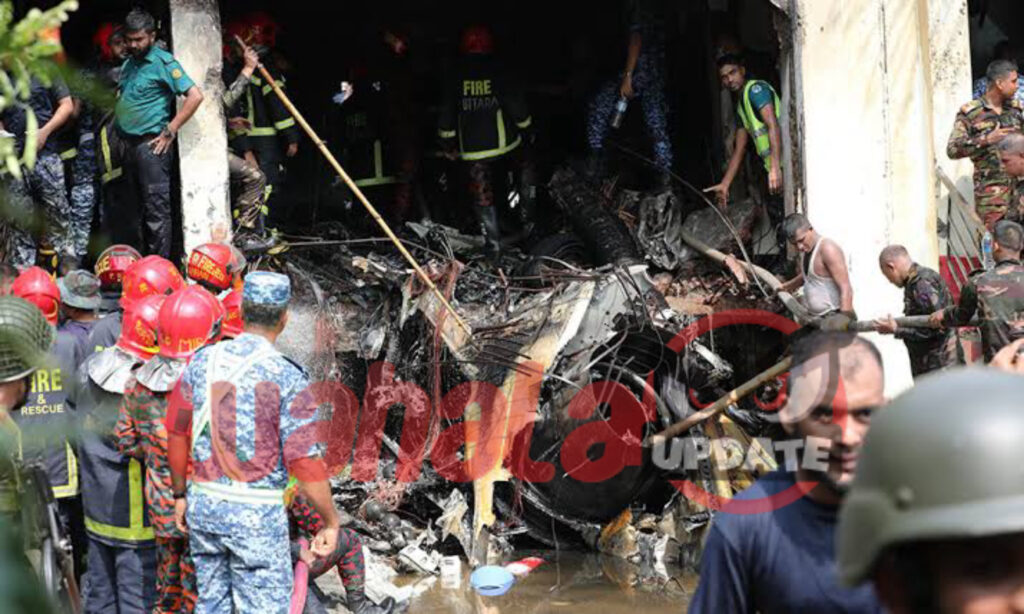A devastating incident unfolded on Monday morning, July 21, 2025 in Dhaka, Bangladesh, when a Bangladesh Air Force F-7 BGI training jet crashed into Milestone School and College.
At least 20 people were killed, while over 100 others sustained injuries, many seriously.
The crash occurred around 8 a.m. local time, turning an ordinary school day into a scene of horror and chaos.
A Deadly Crash on Educational Grounds
The Bangladesh Air Force confirmed the tragic crash, stating the aircraft went down shortly after takeoff in Uttara, a bustling part of Dhaka.
The F-7 BGI jet, typically used for training purposes, crashed directly into the school grounds, impacting both children and adults on site.
The sudden attack by an official military asset on a civilian educational institution raises serious safety concerns that demand urgent scrutiny.
Chaotic Aftermath: Fire and Rescue Efforts
Scenes from the crash site describe a disturbing sight.
Thick smoke and towering flames engulfed the school campus.
Emergency services scrambled quickly, with footage showing firefighters and rescue personnel desperately searching for survivors amid the rubble.
The urgency of the moment was clear as firefighters evacuated bodies from the fiery wreckage while onlookers stood horrified at a distance.
More than fifty people, including children, were rushed to the National Institute of Burn and Plastic Surgery.
A doctor there reported that many suffered severe burns.
Hospitals across Dhaka mobilized resources immediately to treat the influx of victims.
Military Accountability in Question
The Bangladesh military issued a statement acknowledging the crash, but many critics have expressed outrage over the apparent lack of prior safety measures.
The aircraft’s condition, pilot training protocols, and flight clearance procedures are now under intense scrutiny.
How did a military training jet lose control and crash into a school campus located within a populated city area?
This raises crucial questions about the Air Force’s operational standards and risk assessments.
The military’s brief confirmation has been criticized as insufficient and lacking transparency.
The public demands a detailed investigation to uncover whether negligence, mechanical failure, or human error caused the disaster.
Government Response: Sympathy or Deflection?
Muhammad Yunus, head of Bangladesh’s interim government, issued a statement expressing sorrow and promising an investigation.
While he called for hospitals and authorities to handle the situation with “utmost importance.”
Many feel the response is typical political rhetoric, lacking concrete action plans or immediate accountability.
The government declared Tuesday a national day of mourning.
However, grief among citizens is mingled with frustration and skepticism toward officials responsible for preventing such catastrophes.
The Human Cost: Innocent Lives Shattered
This tragedy plunges Bangladesh into mourning for two reasons.
First, the loss of innocent lives children enrolled in a place of learning killed unexpectedly by a military mishap and second, the failure of safety mechanisms meant to protect civilians from such disasters.
Many victims are minors, fueling outrage over the decision to fly training missions near heavily populated areas.
The families of the victims have already expressed heart-wrenching grief, anger, and demands for justice.
Underlying Issues: Military Negligence or Systemic Failure?
Experts have criticized the lack of enforced flight safety zones around civilian establishments in Dhaka.
Military jets regularly fly over populated areas without thorough risk assessments.
The air force has long faced scrutiny for aging equipment and alleged pilot training deficiencies.
This crash could be a tragic symptom of broader systemic issues, including underfunded safety protocols and accountability voids within the Bangladesh military structure.
Public Outcry and Media Reactions
Social media has ignited with condemnations, calls for resignations, and demands for reform in military aviation practices.
The public is unwilling to accept the loss simply as an accident.
Many are questioning why such a high-speed training flight was authorized over a school.
Others are demanding transparency in the forthcoming investigation, warning against attempts to cover up errors.
That Remain Unanswered
Key questions linger. What caused the jet to crash?
Were adequate safety warnings given to the community?
Did air force commanders take necessary precautions to avoid disaster over a school?
While investigations have been promised, the urgency for clarity grows with every passing hour.
Bangladesh’s citizens deserve facts not vague assurances.
A Call for Change amid Tragedy
This catastrophe should serve as a harsh reminder of the dire consequences when military protocols fail in civilian areas.
It highlights the urgent need for reform in how military training flights are conducted in densely inhabited zones.
Bangladesh’s leadership must move beyond condolences and show real accountability.
Otherwise, this tragic loss risks becoming just another statistic in a dire pattern of neglect.



1 Comment
6u07kq